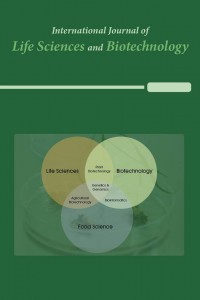Growth Analysis of Lactobacillus acidophilus Using Different Non-Digestible Carbohydrates
Growth Analysis of Lactobacillus acidophilus Using Different Non-Digestible Carbohydrates
non-digestible carbohydrates, L.acidophilus, cell biomass,
___
- 1. Sharifi, M., et al., Kefir: a powerful probiotic with anticancer properties. Medical Oncology, 2017. 34 (11): p. 1-7.
- 2. Zielińska, D. , D. Kolożyn -Krajewska, and M. Laranjo, Food-origin lactic acid bacteria may exhibit probiotic properties: review. BioMed Research International, 2018. p. 1-15.
- 3. Davani-Davari, D., et al., Prebiotics: Definition, types, sources, mechanisms, and clinical applications. Foods, 2019. 8 (3): p. 92.
- 4. Zartl, B., et al., Fermentation of non-digestible raffinose family oligosaccharides and galactomannans by probiotics. Food & Function, 2018. 9 (3): p. 1638-1646.
- 5. Gibson, G. and M.B. Roberfroid, Dietary modulation of the human colonic microbiota: introducing the concept of prebiotics. Journal of Nutrition, 1995. 125 (6): p. 1401– 12.
- 6. Śliżewska, K. and A. Chlebicz-Wójcik, The in vitro analysis of prebiotics to be used as a component of a synbiotic preparation. Nutrients, 2020. 12 (5): p. 1272.
- 7. Markowiak, P. and K. Ślizewska, Effects of probiotics, prebiotics, and synbiotics on human health. Nutrients, 2017. 9 (9): p. 1021.
- 8. Srivastava, R.K, Enhanced shelf life with improved food quality from fermentation processes. Journal of Food Technology and Preservation, 2018. 2 (3): p. 1– 7.
- 9. Colombo, M., et al., Beneficial properties of lactic acid bacteria naturally occurring in dairy production systems. BMC Microbiology, 2018. 18 (1): p. 1-12.
- 10. Dinkçi, N. , V. Akdeniz, and A.S, Akalin, Survival of probiotics in functional foods during shelf life. Food Quality and Shelf Life, 2019. p. 201-233.
- 11. Capozzi, V., et al., Stressors and Food Environment: Toward strategies to improve robustness and stress tolerance in probiotics. Probiotics, Prebiotics, and Synbiotics: Bioactive Foods in Health Promotion, 2016. p. 245-256.
- 12. Atlas, R.M., 2006, The Handbook of Microbiological Media for the Examination of Food. Boca Raton, Fla, USA. p. 246.
- 13. Kepli, A. N., et al., Medium optimization using response surface methodology for high cell mass production of Lactobacillus acidophilus. Journal of Scientific and Industrial Research, 2019. 78 (9): p. 608– 14.
- 14. Arena, M., et al., Barley β -glucans-containing food enhances probiotic performances of beneficial bacteria. International Journal of Molecular Sciences, 2014. 15 (2): p. 3025-3039.
- 15. Suman, D., Barley: A cereal with potential for development of functional fermented foods. Intl. J. Ferment. Food, 2019. 8 (1): p. 1– 13
- 16. Liptáková, D., Z. Matejčeková, and L. Valík, Lactic acid bacteria and fermentation of cereals and pseudocereals. Fermentation Processes, 2017.
- 17. Lee, J.M., et al Improvement of thermostability and halostability of β -1,3-1,4-glucanase by substituting hydrophobic residue for Lys48. International Journal of Biological Macromolecules, 2017. 94. p. 594-602.
- 18. Batista, N.N., et al., Fermentation of yam (Dioscorea spp. L.) by indigenous phytase-producing lactic acid bacteria strains. Brazilian Journal of Microbiology, 2019. 50 (2): p. 507-514.
- 19. Li, T., et al., The beneficial effects of purple yam (: Dioscorea alata L.) resistant starch on hyperlipidemia in high-fat-fed hamsters. Food & Function, 2019. 10 (5): p. 2642-2650.
- 20. Hsu, C.C., et al., Effect of yam (Dioscorea olata compared to Dioscorea japonica) on gastrointestinal function and antioxidant activity in mice. Journal of Food Science, 2006. 71 (7): p. S513-S516.
- 21. Zhang, N., et al., Study on prebiotic effectiveness of neutral garlic fructan in vitro. Food Science and Human Wellness, 2013. 2 (3-4): p. 119-123.
- 22. Martinez-Gutierrez, F., et al., Potential use of Agave salmiana as a prebiotic that stimulates the growth of probiotic bacteria. LWT, 2017. 84. p. 151-159.
- 23. Shalini, R., et al., Growth of selected probiotic bacterial strains with fructans from Nendran banana and garlic. LWT - Food Science and Technology, 2017. 83: p. 68-78.
- 24. Pramono, Y.B., et al., Utilization of lesser yam (Dioscorea esculenta L.) flour as prebiotic in yogurt to total lactic acid bacteria (LAB), sugar reduction, and organoleptic properties. Digital Press Life Sciences, 2020. 2: p. 00011.
- 25. Powthong, P., et al., study of prebiotic properties of selected banana species in Thailand. Journal of Food Science and Technology, 2020. 57 (7): p. 2490-2500.
- 26. Putra, A.N, Sweet potato varieties sukuh potential as a prebiotics in tilapia Feed (Oreochromisniloticus). International Conference of Aquaculture Indonesia, 2014. (1989): p. 254– 58.
- 27. Ikuta, D., et al., Conformationally supple glucose monomers enable synthesis of the smallest cyclodextrins. Science, 2019. 8 (5): p. 674-677.
- 28. Bello, B., et al., Evaluation of the effect of soluble polysaccharides of palm kernel cake as a potential prebiotic on the growth of probiotics. 3 Biotech, 2018. 8 (8): p. 1-14.
- Yayın Aralığı: Yılda 3 Sayı
- Başlangıç: 2018
- Yayıncı: International Society of Academicians
Chukwunonso ACHİFE, Udeme JOSHUA, Jeremiah BALA, Solomon OYELEKE
Yield and Quality Stabilities of Waxy Maize Genotypes using Biplot Analysis
Salvia fruticosa’nın (Anadolu Adaçayı) Terapötik Etkileri
Bitkisel Üretimde Yeni Bir Trend: Kenevir
Fatma Şayan POYRAZ, Edibe ABACI, Caner ERTÜRK, Tayfun ACAR, Serap DERMAN, Semiha ERİŞEN, Banu MANSUROĞLU
Antarktika: Yaşam Bilimleri ve Biyoteknoloji Araştırmalarının Gözden Geçirilmesi
Suleyman Faruk KIRKINCI, Sevgi MARAKLI, Hasan Murat AKSOY, Didem ÖZÇİMEN, Yilmaz KAYA
Growth Analysis of Lactobacillus acidophilus Using Different Non-Digestible Carbohydrates
Haia Abobakr AL-KAF, Fahrul Zaman HUYOP, Noor Azwani ZAİNOL
Lactic Acid Bacterium With Antimicrobial Properties From Selected Malay Traditional Fermented Foods
Tengku Haziyamin TENGKU ABDUL HAMİD, Nur FATİN AMYSYA
How did the Addition of Indaziflam Affect on Carbon and Nitrogen Mineralizations in a Vineyard Soil?
Burak KOÇAK, Şahin CENKSEVEN, Nacide KIZILDAĞ, Hüsniye AKA SAĞLIKER, Cengiz DARICI
Delphinidin, Luteolin and Halogenated Boroxine Modulate CAT Gene Expression in Cultured Lymphocytes
Nikolina TOMİC, Maida HADZİC, Naida LOJO-KADRİC, Jasmin RAMİC, Lejla POJSKİC
